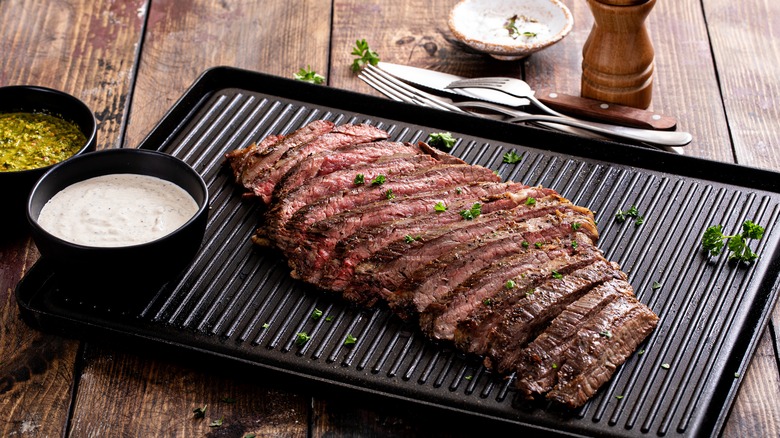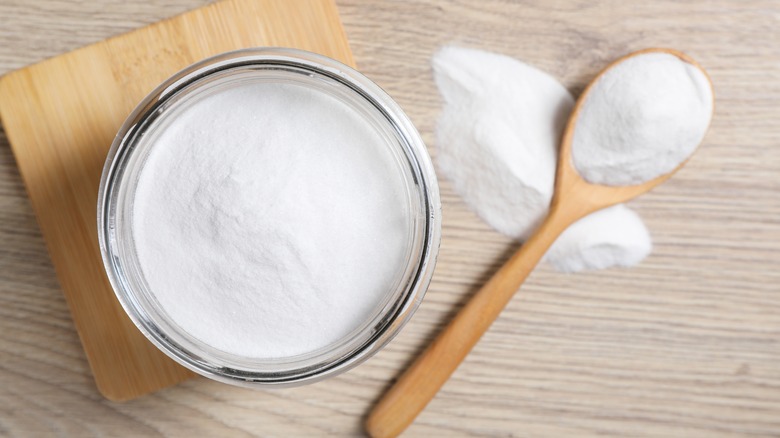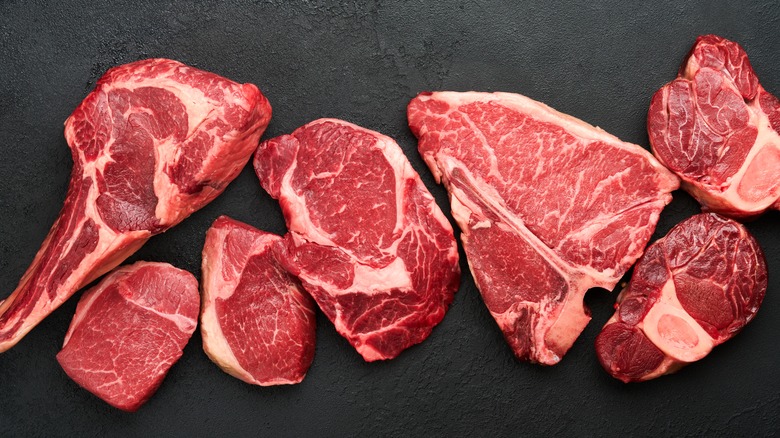Is Baking Soda The One-Ingredient Solution To Tenderizing Steaks?
Some cuts of steak are so tender that they practically melt in your mouth, while others are tough enough that chewing them turns into a jaw workout. To even the playing field so every cut of beef gets a chance to shine, cooks have developed different methods of tenderizing meat. One of the quickest and easiest solutions by far is to use baking soda. Not only does it work in minutes, but as a common ingredient in most home kitchens, it's also readily available.
To tenderize steak with fresh baking soda, you can use either a wet or dry technique. For the wet method, begin by mixing baking soda with water. For every 12 ounces of meat, you'll need a teaspoon of baking soda and ½ cup of water. Once combined, pour this solution onto your steak in a glass bowl and mix to coat all the meat with the solution, then leave it to soak for 15 to 30 minutes. With the dry technique, simply sprinkle the baking soda on the surface of the steak and rub it in. Place in an airtight container and pop it in the fridge to rest for at least three hours or overnight.
Whichever method you use, you'll want to rinse your steak thoroughly before patting it dry, seasoning it, and cooking it as usual. While the results will be magical, this simple yet seriously useful hack for tenderer steak isn't an illusion — and the chemistry behind how it works is fascinating.
Baking soda to the rescue
Baking soda, the fine white powder also known as sodium bicarbonate, is more popular among bakers since it's commonly used as a leavening agent for baked goods. So, how does it work to tenderize steak and other meats? The science is in how this natural chemical alters the protein structures in meats.
When baking soda mixes with steak, it makes it more alkaline (i.e., raises the pH on the meat's surface). As a result, it denatures the tough protein fibers and makes them less tight. With the fibers loosely bound together, your steak acquires a softer, less chewy texture. Additionally, the raised pH increases the affinity of the protein molecules to water, making the steak more succulent; it also helps with browning and char on the outside.
There's only one caveat when using baking soda as a tenderizer: its impact on flavor. Sodium bicarbonate has a metallic taste, which can affect the flavor of your steak. It may not be very overly apparent to every eater, but that subtle shift can make your steak taste slightly off. The only way to avoid or reduce this flavor alteration is to use as little baking soda as possible and, after the soak, run the steak under running water to remove remnants of the chemical.
Why the tenderness of your raw steak matters
When tenderizing steak using baking soda, it helps to understand what makes some steak cuts tough while others are tender — it all boils down to their location on the animal's body. The cuts from the most active parts of the cow are the toughest because the tissues in these regions are more developed and contain lots of collagen. Collagen is a protein that connects muscles to adjacent bone and is generally more difficult to chew than regular muscle fibers. Therefore, any cut of steak with more collagen will inevitably be tougher, and thus well suited to this tenderizing technique.
For example, since a cow's shoulders, rump, and legs are actively used for walking, steaks from those regions, such as top round or eye of round, are pretty tough. Steaks from the belly of the cow (e.g., flank steak, which is great for grilling) are also moderately chewy because these muscles work out a lot as the cow is grazing. On the flip side, the least active parts of the cow, like the back and ribs, produce the tenderest cuts, including filet mignon from the tenderloin and ribeye steak, another prime grilling choice.
Really, any cut of steak will benefit from this kind of tenderizing. It all comes down to finesse, and making sure there's no residual baking soda left when it comes time to season and cook your beef.


